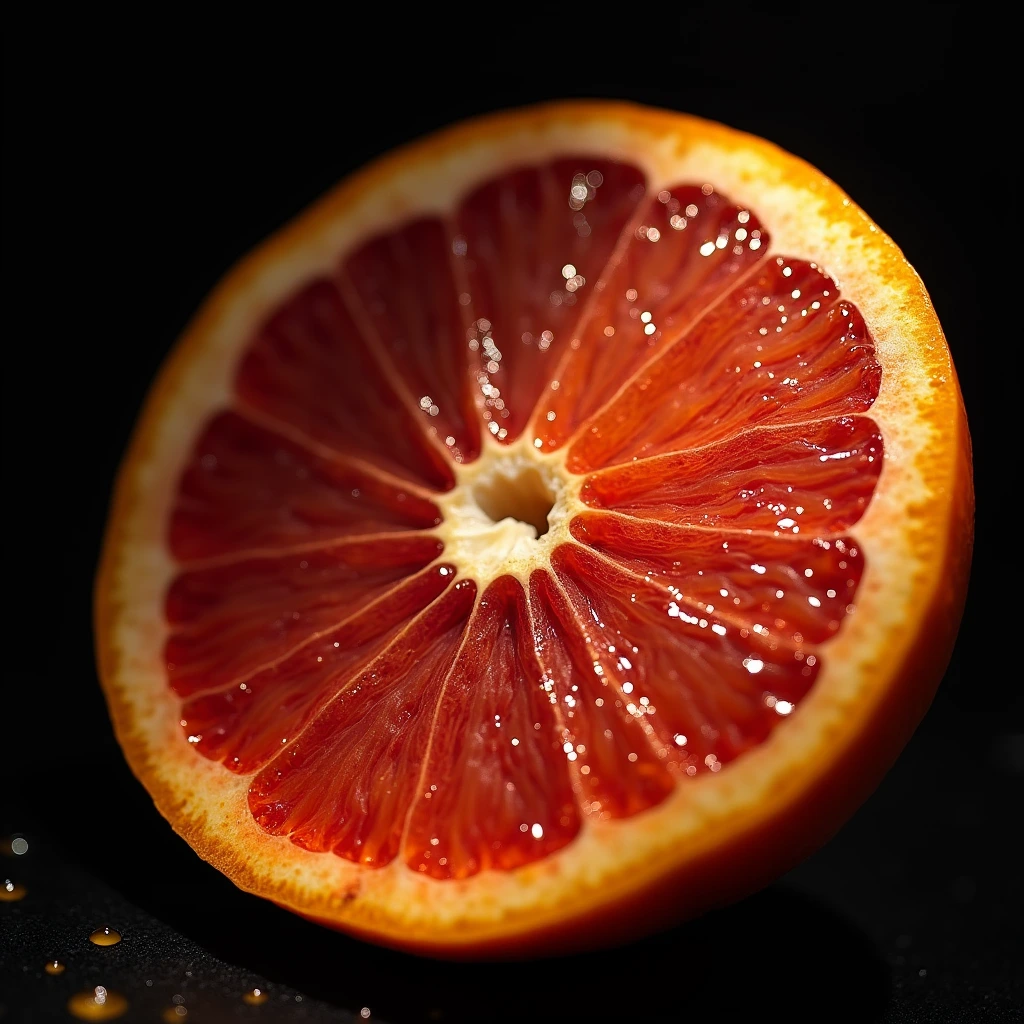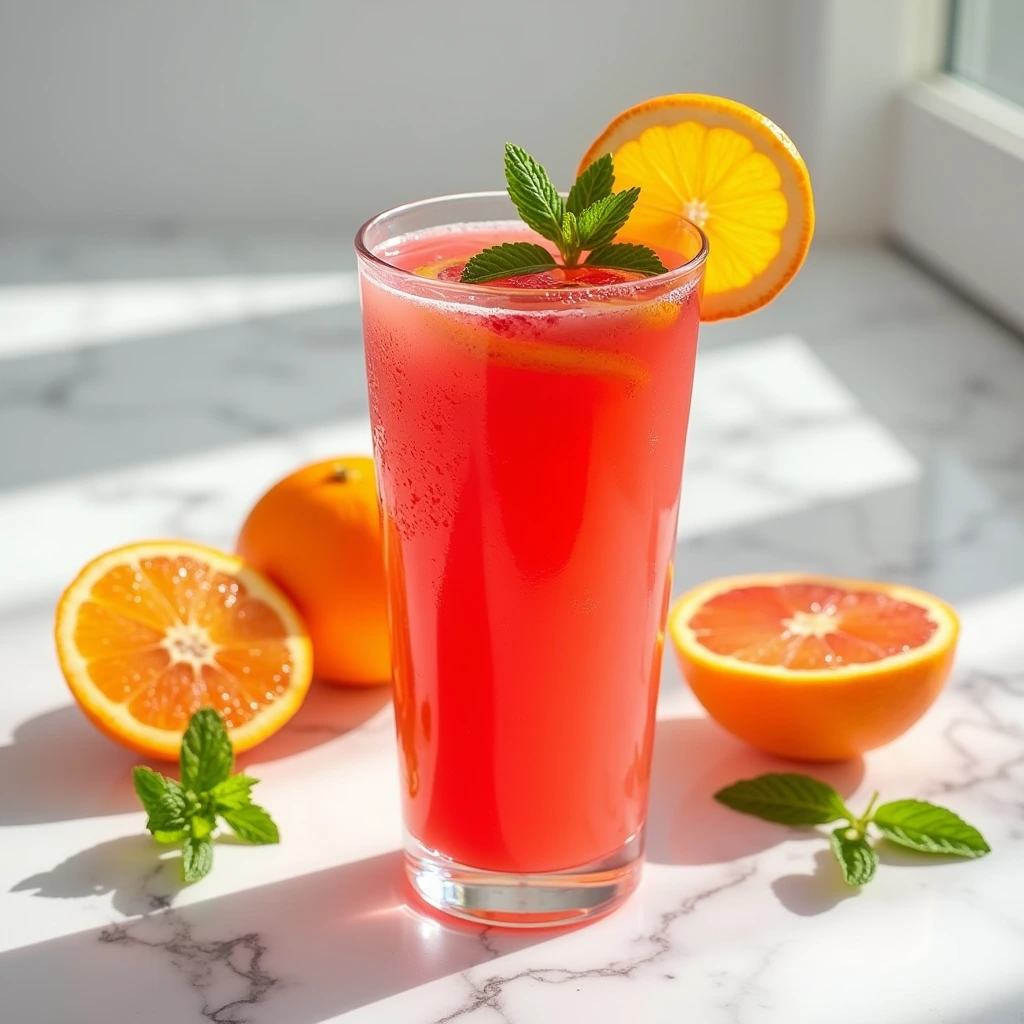
Hey Juice Lover! Meet the Magic of Blood Orange Juice
Ever spotted a vibrant, ruby-red juice that made you stop and stare? That’s the enchanting blood orange juice—a citrusy symphony of flavor, color, and nutrition in every sip!
But what makes it so special? And how can you maximize its benefits? Today, we’re peeling back the layers (pun intended!) to uncover everything you need to know about this extraordinary drink.
Ready for the ultimate guide to blood orange juice? Let’s dive in!
What Makes Blood Orange Juice So Special?
Blood orange juice isn’t just another citrus option—it’s a showstopper! From its stunning color to its bold, complex flavor, every sip feels like a special occasion. Let’s explore what sets it apart.
The Unique Color: Anthocyanins at Work
That rich red hue? It comes from anthocyanins, powerful antioxidants not typically found in other oranges. These pigments shift from blush pink to deep maroon, depending on the variety and growing conditions. It’s like opening a surprise gift with every orange!
Taste Profile: More Than Just Orange
Blood orange juice isn’t just sweet—it’s sophisticated! Expect a flavor that’s:
Less acidic than regular oranges
Tangy with raspberry-like notes
Hints of berries & floral undertones
It’s like orange juice that went to finishing school—zesty, refreshing, and totally irresistible! One sip, and you’ll be hooked.
Nutritional Powerhouse: Why You Should Drink Blood Orange Juice
Beyond its gorgeous color and bold flavor, blood orange juice is a nutrient-packed powerhouse that supports overall health. Here’s why a daily glass might be your new best habit!
Vitamin C Champion: Immune-Boosting Superhero
Blood orange juice is loaded with Vitamin C, giving your immune system a serious boost! It helps:
Fight infections & keep you healthy
Support collagen production for glowing skin
Enhance iron absorption for better energy levels
Antioxidant Power: Your Body’s Natural Defense
Those anthocyanins (responsible for the red hue) are also potent antioxidants that combat free radicals, helping:
Reduce inflammation
Protect cells from damage
Lower the risk of chronic diseases
Other Essential Nutrients
Beyond Vitamin C, blood orange juice provides:
- Folate – Essential for cell growth & function
- Potassium – Helps balance fluids & regulate blood pressure
- Fiber – Supports healthy digestion
Drinking blood orange juice isn’t just delicious—it’s a daily dose of wellness in a glass!
From Grove to Glass: How Blood Orange Juice is Made

Ever wondered about the journey your blood orange juice takes before it lands in your gFrom Grove to Glass: The Journey of Blood Orange Juice
Ever wondered how blood orange juice makes its way from sun-drenched groves to your glass? It’s a fascinating process that blends nature’s perfection with human ingenuity. Let’s break it down!
Selecting the Perfect Blood Oranges
Not all blood oranges are the same—some are sweeter, some are more tart, and their red hues vary. Farmers look for:
Heavy fruit – More weight means more juice!
Firm, smooth skin – A sign of freshness.
Vibrant color – Indicates peak ripeness.
Choosing the best oranges ensures high-quality, flavorful juice—just like selecting top ingredients for a gourmet meal!
The Juicing Process: Tips & Tricks
Once the finest oranges are picked, it’s time for juicing magic! Whether using a manual or commercial juicer, here’s how to get the best results:
Gentle Pressing – Too much pressure releases bitter oils from the peel.
Control the Pulp – Use a sieve for smooth juice or leave it in for texture.
Juice Immediately – Fresher juice = better taste & nutrients!
Don’t Waste the Peel – Zest it for extra flavor in other recipes.
Juicing blood oranges is simple, but the nuances matter—it’s like a dance with the fruit that leads to liquid gold in your glass!
Common Problems & Solutions with Blood Orange Juice
Even with the best practices, you might sometimes encounter a few common issues when dealing with blood orange juice. These issues are usually easily resolved, and understanding them can help you make the most of your blood orange experience. Let’s tackle some of the potential hiccups and how to fix them! It’s all part of the learning process.
Bitterness: Why Does My Juice Taste Bitter?
One of the most common complaints about blood orange juice, especially freshly squeezed juice, is that it can sometimes taste bitter. This bitterness usually stems from the pith (the white part of the orange) or the peel, which contain bitter compounds. Here’s what you can do about it:
- Avoid Excess Pith: When juicing, be careful not to press too hard or extract too much of the white pith.
- Use a Sharp Knife: When cutting the oranges for juicing, use a sharp knife to avoid tearing the pith.
- Strain the Juice: If your juice ends up being bitter, try straining it through a fine-mesh sieve to remove some of the solids that might contribute to the bitterness.
- Balance with Sweetness: If the bitterness persists, you can try adding a small amount of sweetener like honey or maple syrup.
Bitterness doesn’t have to ruin your juice. A little attention to detail during the juicing process can make all the difference.
Sediment: Is That Stuff at the Bottom Normal?
Ever notice a layer of sediment at the bottom of your blood orange juice? Don’t be alarmed; it’s completely normal! This sediment consists mainly of pulp and other natural solids that settle over time. It’s not harmful and doesn’t mean the juice is bad. In fact, some people believe the sediment adds to the overall flavor and texture of the juice! If you find it unappealing, you can gently shake the juice before drinking or carefully pour it out, leaving the sediment at the bottom of the container. It’s a natural occurrence, a sign that your juice is as close to its natural form as possible.
Juice Oxidation: Keeping Your Juice Fresh
Like other juices, blood orange juice is prone to oxidation, which can cause it to lose its vibrant color and develop a slightly off flavor over time. To keep your juice as fresh as possible:
- Store Properly: Store your fresh blood orange juice in an airtight container in the refrigerator.
- Consume Promptly: For the best quality, consume the juice within 24-48 hours after juicing.
- Add Lemon or Lime Juice: Adding a tiny splash of lemon or lime juice can help slow down the oxidation process.
- Freeze it: If you don’t plan on drinking your fresh juice immediately, consider freezing it in ice cube trays for later use.
Oxidation is a natural process, but with a little care, you can keep your blood orange juice tasting fresh and vibrant for longer. It’s all about smart storage and prompt enjoyment.
Creative Ways to Use Blood Orange Juice

Blood orange juice isn’t just for sipping straight from a glass. Its vibrant flavor and color make it a fantastic addition to a wide range of culinary creations and cocktails. From adding a zesty twist to your favorite drinks to enhancing your cooking, the possibilities are nearly endless. Let’s explore some of the creative ways you can incorporate this delicious juice into your daily life. Get ready to be inspired!
Cocktails and Mocktails: Adding a Zesty Twist
Blood orange juice can elevate any cocktail or mocktail with its unique flavor and vibrant color. It brings a touch of sophistication and complexity that is hard to beat. Here are a few ideas to get your creative juices flowing (again, pun intended!):
- Blood Orange Mimosa: Combine blood orange juice with Prosecco or other sparkling wine for a simple yet elegant brunch cocktail. It’s a classic with a twist!
- Blood Orange Margarita: Replace traditional lime juice with blood orange juice for a sweeter, slightly less tart version of this favorite.
- Blood Orange Spritzer: Mix blood orange juice with sparkling water, a splash of lime, and a few mint leaves for a refreshing non-alcoholic drink.
- Blood Orange Old Fashioned: Add a splash of blood orange juice to a classic old fashioned for a citrusy twist.
The possibilities are vast! Blood orange juice can bring a unique and intriguing flavor profile to your favorite drinks. Feel free to experiment with different combinations and find your perfect match. It’s like adding a secret ingredient that everyone will be asking about!
Culinary Delights: From Sauces to Desserts
Beyond beverages, blood orange juice can add a fantastic zing to various dishes, both savory and sweet. Its complex flavor profile makes it a great addition to a wide range of recipes. Here are some ideas:
- Blood Orange Vinaigrette: Combine blood orange juice with olive oil, Dijon mustard, honey, and herbs for a refreshing salad dressing.
- Blood Orange Glaze: Reduce blood orange juice with a bit of sugar and use it as a glaze for roasted chicken, duck, or pork.
- Blood Orange Marinade: Marinate seafood or poultry in blood orange juice, garlic, ginger, and soy sauce for a flavorful punch.
- Blood Orange Sorbet: Combine blood orange juice with sugar and a bit of lemon juice, then freeze for a refreshing dessert.
- Blood Orange Cake or Muffins: Incorporate blood orange juice and zest into your favorite cake or muffin recipe for added flavor and moisture.
The magic of blood orange juice lies in its ability to bring a bright, zesty flavor to both sweet and savory dishes. “It’s like adding sunshine to your food,” a friend once said. It’s such a versatile ingredient that can elevate your culinary creations.
Beyond the Kitchen: Creative Uses for Leftovers
Don’t throw away leftover blood orange peels! They can be used in various creative and useful ways. Here are a few ideas:
- Citrus Cleaner: Boil the peels in water, then use the liquid to clean surfaces and freshen your kitchen.
- Aromatic Potpourri: Dry the peels and use them in potpourri mixes to add a refreshing citrus scent to your home.
- Infused Oil: Infuse olive oil with blood orange peels for a flavorful addition to salad dressings or marinades.
- Candied Peels: Candied blood orange peels are a great snack or garnish for baked goods.
It’s amazing how something that seems like waste can be transformed into something beautiful and useful. It’s about reducing waste and getting the most out of every ingredient.
Buying Guide: What to Look for When Buying Blood Orange Juice
When you’re at the store looking for blood orange juice, you might be faced with a variety of options. It’s important to know what to look for to ensure you’re getting the best quality and the most value. Let’s take a look at some key factors to consider. Knowledge is power, especially when it comes to shopping!
Fresh vs. Bottled: Which is Best?
The age-old question: fresh or bottled? Freshly squeezed blood orange juice is typically the best in terms of flavor and nutritional value, as it hasn’t been pasteurized or processed. However, it also has a shorter shelf life. Bottled juice, on the other hand, is more convenient and can last longer, but it might contain added sugars or preservatives. The ideal choice depends on your personal preference and lifestyle. If you have the time and resources, fresh juice is usually the way to go. If convenience is a priority, opt for a high-quality bottled juice. Just make sure to read the labels carefully.
Reading the Labels: What to Avoid
When buying bottled blood orange juice, it’s essential to carefully read the labels. Here are some things to watch out for:
- Added Sugars: Many commercially produced juices contain added sugars, which can be detrimental to your health. Opt for juices with no added sugars or sweeteners.
- Preservatives: Some juices contain artificial preservatives to extend their shelf life. Choose those with minimal or no artificial additives.
- Concentrate: Look for juices labeled “not from concentrate.” These juices are closer to the fresh-squeezed version.
- Artificial Colors: Some juices might contain artificial colors to enhance their appearance. Avoid those with artificial colors, as they are often unnecessary.
Taking the time to read the labels can help you make informed choices and choose the healthiest option. It’s about being a smart consumer and prioritizing quality ingredients.
The Environmental Impact of Blood Orange Production
It’s important to also consider the environmental impact of the products we consume. Blood orange farming, like any agricultural practice, can have an effect on the environment. Choosing sustainably produced products can help lessen your impact. Let’s take a closer look at how we can make better choices.
Sustainable Farming Practices
Sustainable farming practices are essential for minimizing the environmental impact of blood orange production. These practices may include:
- Organic Farming: Organic farming avoids the use of synthetic pesticides and fertilizers, which can be harmful to the environment.
- Water Conservation: Implementing water-efficient irrigation techniques to conserve water resources.
- Soil Health: Employing practices that promote healthy soil, such as crop rotation and cover cropping.
- Biodiversity: Supporting farms that encourage biodiversity by preserving natural habitats.
Choosing blood oranges from farms that adhere to these practices is crucial for supporting environmental sustainability. It’s about making conscious choices that benefit both the planet and your health.
Choosing Eco-Friendly Brands
When purchasing blood orange juice, look for brands that prioritize sustainability. This might include brands that:
- Use eco-friendly packaging materials.
- Source their oranges from farms with sustainable farming practices.
- Are transparent about their production practices.
- Support fair trade and ethical sourcing.
Your purchasing power can have a positive impact on the environment. By supporting brands that are committed to sustainability, you’re contributing to a healthier planet. It’s a win-win!
Blood Orange Juice: A Delicious Journey
From its vibrant color to its unique flavor and nutritional benefits, blood orange juice is truly a special drink. It’s a versatile ingredient that can be enjoyed in countless ways, from simple sipping to culinary masterpieces. I hope this guide has helped you discover the wonders of this fantastic juice. Cheers to enjoying this zesty delight!
Beyond the Juice: Pairing Blood Orange with Your Meals
Blood orange juice, with its zesty and slightly tangy profile, isn’t just a refreshing drink; it can also be a fantastic culinary companion. Its complex flavors can complement a wide array of dishes, enhancing both sweet and savory creations. Imagine starting your day with a glass of freshly squeezed blood orange juice alongside a homemade sourdough bagel, the subtle citrus notes perfectly balancing the tangy bread (see our ultimate sourdough bagel recipe). For lunch, consider incorporating blood orange segments into a vibrant salad, perhaps with a touch of sweet and sour relish, adding a delightful citrusy twist (check out our easy chow chow relish recipe). Moving onto dinner, a light and flaky branzino, drizzled with a blood orange glaze, would be an elegant and flavorful pairing (discover the ultimate branzino recipe). Even a simple dish like pan-fried tauhu can be elevated with a squeeze of blood orange, creating a uniquely balanced and delicious experience (explore our easy tauhu recipe). The versatility of blood orange juice knows no bounds, making it an incredible ingredient to explore in your kitchen.
Frequently Asked Questions About Blood Orange Juice
Okay, let’s wrap things up by addressing some common questions about blood orange juice. If you’ve still got some burning questions, hopefully, these will clear things up. Let’s get to it!
Is Blood Orange Juice Safe for Everyone?
Generally, blood orange juice is safe for most people. However, like other citrus juices, it can be acidic and may cause heartburn or indigestion in some individuals. People with citrus allergies should avoid it. If you have specific health concerns, consult with your doctor or a registered dietitian. As with any food or drink, moderation is key.
How Long Does Fresh Blood Orange Juice Last?
Freshly squeezed blood orange juice is best consumed within 24-48 hours when stored in an airtight container in the refrigerator. After this time, the juice may start to lose its freshness and flavor. If you want to keep it longer, consider freezing it.
Can Blood Orange Juice Help Me Lose Weight?
Blood orange juice is low in calories and high in nutrients, making it a good addition to a balanced diet. However, it’s not a magic weight-loss solution. Weight loss is best achieved through a combination of a healthy diet and regular exercise. Blood orange juice can be a healthy and flavorful part of your diet, but it’s not the sole solution for weight management.
Okay, that’s the end of Part 3 and the full article! I’m ready for your feedback, the meta description request, and any further instructions. Let me know what you think!
